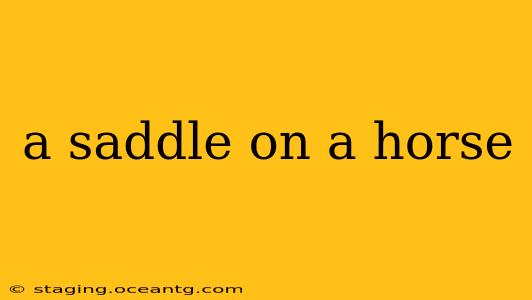The seemingly simple act of placing a saddle on a horse belies a rich history and a complex relationship between human and animal. More than just a seat, the saddle is a crucial piece of equestrian equipment that provides comfort, control, and safety for both rider and horse. Understanding its function, types, and history is key to appreciating its importance in the world of horseback riding.
What is the purpose of a saddle on a horse?
The primary purpose of a saddle is to provide a comfortable and secure seat for the rider. Without a saddle, riding a horse for any extended period would be extremely uncomfortable and potentially dangerous, leading to chafing, fatigue, and an unstable riding position. The saddle distributes the rider's weight evenly across the horse's back, preventing undue pressure on specific points. This even weight distribution is crucial for the horse's comfort and well-being. Beyond comfort, the saddle also provides a secure platform for the rider to maintain balance and control, enabling them to guide the horse effectively.
What are the different types of saddles?
There's a vast array of saddle types, each designed for specific riding disciplines and purposes. The choice of saddle significantly impacts the rider's experience and the horse's comfort. Some of the most common types include:
-
English Saddles: Known for their sleek design and close contact with the horse, English saddles are popular for disciplines like dressage, jumping, and eventing. Variations within English saddles include the dressage saddle (deep seat, long flaps), jumping saddle (forward flaps for clearance), and general-purpose saddles (versatile design).
-
Western Saddles: Characterized by their larger size, deeper seat, and high cantle (back of the saddle), Western saddles are used primarily in Western riding disciplines such as trail riding, roping, and barrel racing. They often incorporate features like a horn (for roping) and fenders (for leg support).
-
Endurance Saddles: Designed for long-distance riding, endurance saddles prioritize both rider and horse comfort. They often feature lightweight materials, ample padding, and a design that allows for a more natural gait for the horse.
-
Specialized Saddles: There are saddles specifically designed for therapeutic riding, para-equestrian sports, and other unique applications. These saddles are often customized to meet the specific needs of both the rider and the horse.
How do you put a saddle on a horse?
Putting a saddle on a horse correctly is crucial for both safety and comfort. Improper saddling can lead to sores and discomfort for the horse. The process generally involves:
- Checking the saddle pad: Ensure the pad is clean, properly fitted, and correctly placed on the horse's back.
- Placing the saddle: Carefully lift the saddle onto the horse's back, ensuring it's positioned centrally and evenly.
- Adjusting the girth: Securely fasten the girth, but not too tightly. The girth should be snug enough to prevent the saddle from slipping, but not so tight that it restricts the horse's breathing or causes discomfort.
How much does a horse saddle weigh?
The weight of a horse saddle varies considerably depending on the type, materials, and construction. Generally, English saddles range from 15 to 25 pounds, while Western saddles can weigh anywhere from 25 to 40 pounds or more. The weight is an important factor to consider, particularly for younger or smaller horses.
What is the best saddle for a beginner rider?
For beginner riders, a comfortable and well-balanced all-purpose saddle is often recommended. These saddles offer versatility and are suitable for a range of riding activities. It is vital to get professional advice from an experienced riding instructor or saddler to find a saddle that fits both the horse and rider appropriately.
How do you choose a saddle for your horse?
Choosing a saddle involves considering several factors:
- Horse's conformation: The saddle must fit the horse's back properly, avoiding pressure points and ensuring even weight distribution. A professional saddle fitter should be consulted.
- Rider's build and riding style: The saddle should provide a comfortable and secure seat for the rider, allowing for proper posture and balance.
- Riding discipline: The saddle should be appropriate for the chosen riding discipline.
Choosing the right saddle is a crucial investment that significantly impacts both the rider's comfort and the horse's well-being. Careful consideration of these factors, along with professional advice, will help ensure a safe and enjoyable riding experience.
